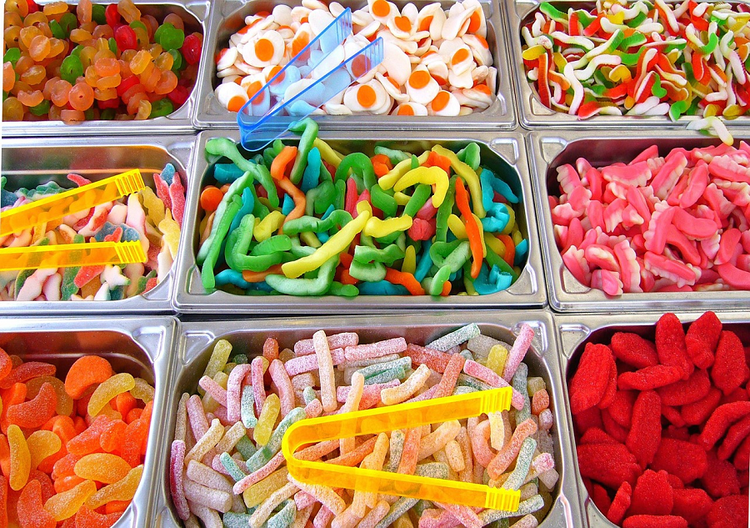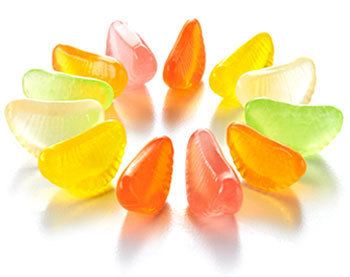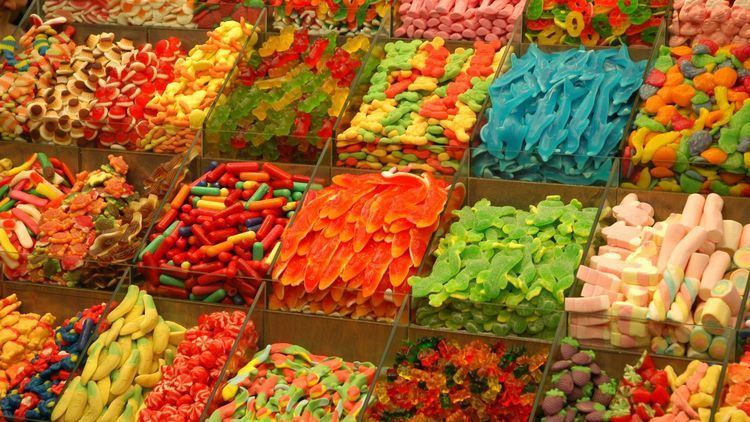Alternative names Gummies, jelly sweets Place of origin Germany Main ingredients Gelatin | Type Confectionery Created by Hans Riegel Sr. | |
 | ||
Variations Gummi bear, gummi worms Similar Gummy bear, Gelatin dessert, Marshmallow, Lollipop, Jelly bean | ||
Jelly belly pet rat gummi candy runforthecube candy review
Gummi, gummy, gummies, or jelly candies are a broad category of gelatin-based, chewable sweets. Gummi bears are widely popular and are a well-known part of the sweets industry. Gummies are available in a wide variety of shapes including bears, bottles, worms, frogs, hamburgers, sharks, toy soldiers, full-size rats, large human body parts (such as hearts and feet), Ampelmännchen (the little figures on pedestrian traffic lights in Eastern Germany) and even the Smurfs. Various brands such as Haribo, Betty Crocker, Disney and Kellogg's manufacture various forms of Gummi snacks, often targeted at young children. The candy and the name "gummi" originated in Germany.
Contents
- Jelly belly pet rat gummi candy runforthecube candy review
- Jelly belly pet rat gummi candy
- History
- Bears
- Bottles
- Rings
- Red frogs
- Road kill gummies
- Teeth gummies
- Worm gummies
- Shark gummies
- Vitamin gummies
- Health considerations
- References

Jelly belly pet rat gummi candy
History

Bears
The gummi bear originated in Germany, where it is popular under the name Gummibär (rubber bear) or Gummibärchen (little rubber bear). Hans Riegel Sr., a candy maker from Bonn, produced these sweets under the Haribo company, which he started in 1920.
Bottles
Cola bottles are sweets in the shape of classic Coca-Cola-style bottles with a cola flavor. They are produced by numerous companies. "Fizzy Blue Bottles", made by Lutti (formerly part of the French division of the Leaf Candy Company, now controlled by a private investment group), are sweets typically found in a pick and mix selection. These are very similar to cola bottle gummies in shape, but they are usually sour and coloured blue and pink. "Blue Bottles", a variation from another company, are identifiable by the small rims around the sides, and are chewier and thicker, with a sweeter taste.
Rings
Ring-shaped gummi candy is often covered in sugar or sour powder. The most common and popular flavor is the peach ring. Other flavors include green apple, melon, blue raspberry, strawberry, and aniseed - although these are typically coated in chocolate. A commonly known producer of gummi rings is Trolli, for which the gummi rings are an important asset.
Red frogs
In Australia, jelly confectionery in the shape of frogs has been very popular since the 1930s. They are colored red or green, although they are usually referred to as "red frogs". These have influenced the shape, structure, consistency and formula that makes gummy bears.
Road kill gummies
In February 2005, following complaints by the New Jersey Society for the Prevention of Cruelty to Animals, Kraft decided to stop production of the controversial Trolli U.S. Road Kill Gummies. The society complained that the products, shaped as partly flattened squirrels, chickens and snakes, would give children an incorrect message on the proper treatment of animals.
Teeth gummies
In Australia, jelly confectionery in the shape of teeth has been very popular since the 1930s. They are colored pink and white, with pink representing the gums and teeth being white. They have a slight minty flavor, similar to mint toothpaste.
Worm gummies
There are many types of Gummy Worms, and Trolli produces glow worm gummies, with glowing color and sour sugar.
Shark gummies
There are also many types of gummy sharks but the blue and white ones are the most popular.
Vitamin gummies
There are also several multi-vitamin gummi bears, usually marketed for children, such as Flintstones Chewable Vitamins. These form of vitamins give off nutrients and protein for those that do not swallow pills or need various supplements to stay healthy.
Health considerations
Gummies landed on the "What's out in 2009" list for some Canadian schools, along with chocolate, fudge, chocolate coated nuts and fruit, bubble gum, lollipops, toffee, jelly beans, marshmallows, sherbet, and Turkish delight. An audit in Victoria, British Columbia, was planned for 2009 to ensure the government banned the selling of the confectionery treat in school stores and vending machines as directed.
Scientists have studied adding the tooth-protecting sugar substitute xylitol to gummies to fight tooth decay.
Choking risks are higher with gummi candies; research shows that "hard, round foods with high elasticity or lubricity properties, or both, pose a significant level of risk." especially to children younger than three years old. This can be resolved with the Heimlich maneuver.
